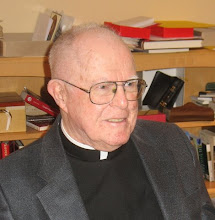CORPUS CHRISTI AT ST. ANN'S
After retirement in 1996 as pastor of The Epiphany Parish in Manhattan, I served as Weekend Associate at St. Ann's in Ossining, NY for ten years until age sounded its retreat.Its liturgies and music capture the solemnity and spirituality of, at this season, Holy Week.
Holy Thursday evening: The side altar, alive with flowers, had been prepared to receive the Blessed Sacrament.The first reading of the Mass was from Exodus, the directions by Moses for preparing the Passover meal. The second reading from Paul describes the Last Supper scene, where Jesus transforms bread and wine into His sacramental presence. The Gospel from John tells of Jesus washing the feet of His disciples as a sign of humility, and of this, He says, "I have given you a model to follow..." This washing was more simply carried out in those days of sandals than at present with more complex foot coverings. St. Ann's and other parishes have accomodated this sign of humility by having members of the clergy, at four posts in the sanctuary, pour water over the hands of each parishioner and then dry them with towels furnished by acolytes.
Members of the congregation then dress the altar with its linens, candles, missal, chalice, and a number of ciboriums for the many hosts consecrated to accomodate Good Friday's service, when the Mass itself is not offered. The offertory hymn, "We Come To Your Feast" captures the diversity of participants, "The young and the old, the bright and the bold, the greatest and the least", and we might think, "the traditionalists and the progressives, the liberals and conservatives, Republicans and Democrats, the immigrants and the locals, we come to your feast".
After Communion with its "Panis Angelicus", the procession begins its reverent journey around the church, headed by the cross, then the vested boy and girl acolytes, clergy, and the celebrant, preceeded by a swirling cloud of incense. Varied hymns accompany the ever so slow pace, first by a Portugese group, then an Italian, on to Spanish, then Filipino, and finally the "Pange Lingua" in English. The Sacrament is placed on the Altar of Repose for the continued devotion of those who choose to remain. The church closes at midnight. An Hispanic group continues a vigil service in the school through the night.
The Feast of Corpus Christi began in Liege, Belgium in 1246 at the initiative of a nun, St. Juliana of Mont Cornillon. She was a friend of Robert of Thorete, Bishop of Liege, who instituted the feast in his diocese, as bishops at that time could do. Juliana was also a friend of Jacques Pantaleon, Bishop of Verdun and later Pope Urban IV. It was this pope who established the feast for the universal church in 1264. In the early 1300rds, England took up its observance with majestic processions featuring the various occupational guilds. All expressive of devotion to Jesus!
Holy Thursday evening: The side altar, alive with flowers, had been prepared to receive the Blessed Sacrament.The first reading of the Mass was from Exodus, the directions by Moses for preparing the Passover meal. The second reading from Paul describes the Last Supper scene, where Jesus transforms bread and wine into His sacramental presence. The Gospel from John tells of Jesus washing the feet of His disciples as a sign of humility, and of this, He says, "I have given you a model to follow..." This washing was more simply carried out in those days of sandals than at present with more complex foot coverings. St. Ann's and other parishes have accomodated this sign of humility by having members of the clergy, at four posts in the sanctuary, pour water over the hands of each parishioner and then dry them with towels furnished by acolytes.
Members of the congregation then dress the altar with its linens, candles, missal, chalice, and a number of ciboriums for the many hosts consecrated to accomodate Good Friday's service, when the Mass itself is not offered. The offertory hymn, "We Come To Your Feast" captures the diversity of participants, "The young and the old, the bright and the bold, the greatest and the least", and we might think, "the traditionalists and the progressives, the liberals and conservatives, Republicans and Democrats, the immigrants and the locals, we come to your feast".
After Communion with its "Panis Angelicus", the procession begins its reverent journey around the church, headed by the cross, then the vested boy and girl acolytes, clergy, and the celebrant, preceeded by a swirling cloud of incense. Varied hymns accompany the ever so slow pace, first by a Portugese group, then an Italian, on to Spanish, then Filipino, and finally the "Pange Lingua" in English. The Sacrament is placed on the Altar of Repose for the continued devotion of those who choose to remain. The church closes at midnight. An Hispanic group continues a vigil service in the school through the night.
The Feast of Corpus Christi began in Liege, Belgium in 1246 at the initiative of a nun, St. Juliana of Mont Cornillon. She was a friend of Robert of Thorete, Bishop of Liege, who instituted the feast in his diocese, as bishops at that time could do. Juliana was also a friend of Jacques Pantaleon, Bishop of Verdun and later Pope Urban IV. It was this pope who established the feast for the universal church in 1264. In the early 1300rds, England took up its observance with majestic processions featuring the various occupational guilds. All expressive of devotion to Jesus!

